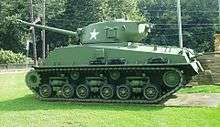Death Traps
 Cover of the 1998 hardcover first edition | |
| Author | Belton Y. Cooper |
|---|---|
| Publisher |
Presidio Press (1st edition) Ballantine Books (paperback) |
Publication date |
August 4, 1998 (1st edition hardback) April 29, 2003 (4th edition paperback) |
| ISBN | 0891416706 |
Death Traps: The Survival of an American Armored Division in World War II is a 1998 memoir by Belton Y. Cooper. The book relates Cooper's experiences during World War II and puts forth an argument against the U.S. Army's use of the M4 Sherman tank during the war.
Belton Y. Cooper
Belton Youngblood Cooper (October 4, 1917 - May 26, 2007) served as an ordnance liaison officer in the armored maintenance battalion of the United States' 3rd Armored Division during World War II, and saw action from the Invasion of Normandy in 1944 through the Allied invasion of Germany in 1945.[1][2] Cooper was tasked with the "recovery, repair, and maintenance" of US tanks during the war. As part of his dutites he regularly traveled through "the void" between the front lines and US supply trains to deliver loss reports to commanders, an exercise he referred to as "running the gauntlet", due to the tendency of Allied armored forces to bypass some German elements in their advance, leaving pockets of enemy forces between the quickly advancing armor, and the trailing infantry units.[3]
The Sherman and Pershing

Cooper takes the position that the ultimate decision by the US Army, largely influenced by General George S. Patton, to favor the smaller M4 Sherman medium tank over the heavier M26 Pershing tank was a poor one.[4][5] Cooper cites in part, the large number of casualties the comparatively lightly armored Sherman suffered against the superior German tanks:
The 3rd Armored Division entered combat in Normandy with 232 M4 Sherman tanks. During the European Campaign, the Division had some 648 Shermans completely destroyed in combat and we had another 700 knocked out, repaired, and put back into operation. This was a loss rate of 580 percent.[6]
Cooper argues that, when compared to the Sherman, the Pershing would have been better armed, better armored, more reliable, and more mobile. He blames the Army's preference for the Sherman, on the notion that building a tank like the more expensive Pershing was unnecessary, because "tanks were not meant to fight other tanks".[6]
Reception
Death Traps has received mixed reviews since its release; the way Cooper described his experiences during the war has been praised, but the book also has received criticism for Cooper's attempts to pass judgment on events he never directly experienced, as well as the number of completely unfounded statements and historical inaccuracies it contains.
Publishers Weekly wrote of Death Traps in 1998 that, "Without a doubt, this is one of the finest WWII memoirs ever written by an American junior officer," and predicted it would become "required reading for anyone interested in armored warfare."[1] In the foreword to the book, Stephen E. Ambrose wrote, "Cooper saw more of the war than most junior officers, and he writes about it better than almost anyone."[7] The Library Journal wrote: "[Readers] will be left with an indelible impression of the importance of the support troops and how dependent combat forces were on them.”[7]
The website Tank and AFV News as well as historian Robert Forczyk were critical of the book and the reliance it has garnered online and in media coverage, writing:
As a memoir, it is meandering and repetitive, far too often wandering away from the authors personal experiences into the realm of speculation. As a history it is lacking, containing no end notes, foot notes or bibliography. And finally, as an indictment of the M4 Sherman tank, the book is filled with so many factual errors and outright falsehoods, it cannot be taken seriously on this count either.[5]
Writing in the Air and Space Power Journal[lower-alpha 1] US Air Force Major Gary Pounder described the book as "well worth reading" but "not without its faults," citing a dearth of maps and illustrations, and describing Cooper as being at times a "plodding writer" with a tendency to rehash statistics that have already been covered in previous chapters.[4]
Media
- Death Traps was one of the inspirations behind director David Ayer's 2014 movie Fury, starring Brad Pitt, Shia LaBeouf, and others.[8][9]
- The book was the basis for a portion of an episode of the network History's[lower-alpha 2] show Modern Marvels entitled Engineering Disasters, which focused on the Sherman tank.[5]
See also
Notes
References
- 1 2 "Death Traps: The Survival of an American Armored Division in World War II". Publishers Weekly. Retrieved 19 June 2017.
- ↑ Sudmeier, Jim. "Lt. Belton Y. Cooper, 18th Armored Ordnance Battalion, 3rd Armored Division, First Army". jimsudmeier.com. Retrieved 19 June 2017.
- ↑ Durand, Mike (4 February 2017). "YWR: The True Story that Inspired ‘Fury’". Breach Bang Clear. Retrieved 19 June 2017.
- 1 2 Pounder, Maj Gary (Summer 2001). "Death Traps: The Survival of an American Armored Division in World War II.". Aerospace Power Journal: 112. Retrieved 19 June 2017.
- 1 2 3 "From the Editor: Debunking Deathtraps Part 1". Tank and AFV News. Retrieved 19 June 2017.
- 1 2 Fox, Jacob. "The Wrong Track: Errors in American Tank Development in World War II". Retrieved 19 June 2017.
- 1 2 "Death Traps: the survival of an American armored division in World War II". Penguin Random House. Retrieved 19 June 2017.
- ↑ Cieply, Michael. "‘Fury,’ Starring Brad Pitt, a Raw Look at Warfare". The New York Times. Retrieved 19 June 2017.
- ↑ Neumyer, Scott (22 January 2015). "Exclusive Clip: Fury’s Michael Peña Explains What It’s Like Driving a Tank". Parade. Retrieved 19 June 2017.
External links
- Death traps : the survival of an American armored division in World War II in libraries (WorldCat catalog)
- Belton Youngblood Cooper at Find a Grave